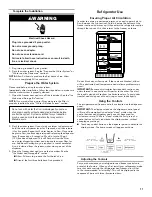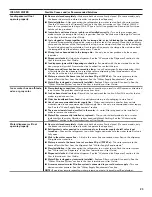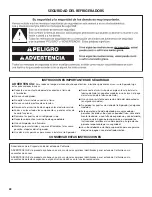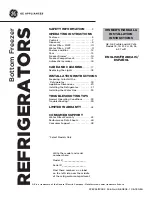
19
IMPORTANT:
This cleaner is for stainless steel parts only.
■
Do not allow the Stainless Steel Cleaner and Polish to come
into contact with any plastic parts such as the trim pieces,
dispenser covers or door gaskets. If unintentional contact
does occur, clean plastic part with a sponge and mild
detergent in warm water. Dry thoroughly with a soft cloth.
5. If your model has a touch screen display on the dispenser
panel, clean the screen using a soft, lint-free cloth. Mix a mild
detergent with water, then use the mixture to dampen the cloth
and gently wipe the screen.
■
To avoid unintentionally changing settings, make sure the
refrigerator is unplugged or the power is disconnected
before wiping the screen.
■
Do not over-saturate the cloth. Do not spray or wipe
liquids directly onto the screen. Do not use abrasive or
harsh cleaners such as window sprays, scouring cleansers,
flammable fluids, cleaning waxes, concentrated detergents,
nail polish remover, bleaches or cleansers containing
petroleum products. Do not use paper towels, scouring
pads, or other harsh cleaning tools. These can scratch or
damage materials.
6. There is no need for routine condenser cleaning in normal
home operating environments. If the environment is particularly
greasy or dusty, or there is significant pet traffic in the home,
the condenser should be cleaned every 2 to 3 months to ensure
maximum efficiency.
If you need to clean the condenser:
■
Remove the base grille. See the “Base Grille” graphic or
“Base Grille” section.
■
Use a vacuum cleaner with a soft brush to clean the grille,
the open areas behind the grille and the front surface area
of the condenser.
■
Replace the base grille when finished.
7. Plug in refrigerator or reconnect power.
Lights
NOTE:
Not all appliance bulbs will fit your refrigerator. Be sure to
replace the bulb with one of the same size and shape.
■
The dispenser lights are LEDs that cannot be changed.
■
On some models, the interior lights are LEDs that cannot
be changed.
■
On some models, the interior lights require a 40-watt bulb.
1. Unplug refrigerator or disconnect power.
2. Remove light shield when applicable, as explained in the
following sections.
NOTE:
To clean the light shield, wash it with warm water and
liquid detergent. Rinse and dry the shield well.
3. Remove light bulb and replace with one of the same size, shape
and wattage.
4. Replace light shield when applicable as shown.
5. Plug in refrigerator or reconnect power.
Power Interruptions
If the power will be out for 24 hours or less, keep the door or
doors closed (depending on your model) to help food stay cold
and frozen.
If the power will be out for more than 24 hours, do one of the
following:
■
Remove all frozen food and store it in a frozen food locker.
■
Place 2 lbs (907 g) of dry ice in the freezer for every cubic
foot (28 L) of freezer space. This will keep the food frozen for
2 to 4 days.
■
If neither a food locker nor dry ice is available, consume or can
perishable food at once.
REMEMBER:
A full freezer stays cold longer than a partially filled
one. A freezer full of meat stays cold longer than a freezer full of
baked goods. If you see that food contains ice crystals, it may be
refrozen, although the quality and flavor may be affected. If the
condition of the food is poor, dispose of it.
Vacation and Moving Care
Vacations
If You Choose to Leave Refrigerator On While You Are
Away:
1. Use up any perishables and freeze other items.
2. If your refrigerator has an automatic ice maker and is
connected to the household water supply, turn off the water
supply to the refrigerator. Property damage can occur if the
water supply is not turned off.
3.
If you have an automatic ice maker, turn off the ice maker.
NOTE:
Depending on your model, raise the wire shutoff arm to
the Off (up) position or press the switch to Off (left).
4. Empty the ice bin.
If You Choose to Turn Refrigerator Off Before You Leave:
1. Remove all food from the refrigerator.
2. If your refrigerator has an automatic ice maker:
■
Turn off the water supply to the ice maker at least one day
ahead of time.
■
When the last load of ice drops, raise the wire shutoff
arm to the Off (up) position or move the switch to the
Off (left)
setting.
3. Unplug refrigerator.
4. Clean, wipe, and dry thoroughly.
5. Tape rubber or wood blocks to the tops of both doors to prop
them open far enough for air to get in. This stops odor and
mold from building up.
Moving
When you are moving your refrigerator to a new home, follow
these steps to prepare it for the move.
1. If your refrigerator has an automatic ice maker:
■
Turn off the water supply to the ice maker at least one day
ahead of time.
■
Disconnect the water line from the back of the refrigerator.
■
When the last load of ice drops, raise the wire shutoff
arm to the Off (up) position or move the switch to the
off setting.
2. Remove all food from the refrigerator and pack all frozen food
in dry ice.
3. Empty the ice bin.
4. Unplug refrigerator.
5. Clean, wipe, and dry thoroughly.
6. Take out all removable parts, wrap them well, and tape them
together so they don’t shift and rattle during the move.
7. Depending on the model, raise the front of the refrigerator so
it rolls more easily or screw in the leveling legs so they don't
scrape the floor. See the “Adjust the Doors” or the “Door
Removal, Leveling, and Alignment” sections.
8. Tape the doors closed and tape the power cord to the back of
the refrigerator.
When you get to your new home, put everything back and refer to
the Installation Instructions for preparation instructions. Also, if your
refrigerator has an automatic ice maker, remember to reconnect
the water supply to the refrigerator.
















































